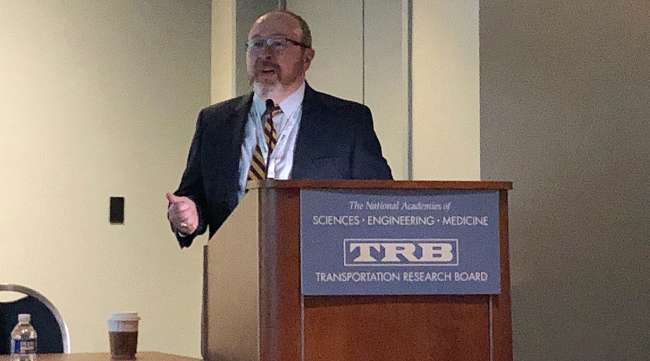Senior Reporter
FHWA to Release Updated Jason’s Law Truck Parking Survey

[Stay on top of transportation news: Get TTNews in your inbox.]
WASHINGTON — Results of a comprehensive national federal survey of truck parking availability will be made public in the next few months, according to a Jan. 15 presentation at the Transportation Research Board annual meeting.
More than 8,000 truck drivers participated in the so-called update of the 2015 Jason’s Law Survey, said Jeff Purdy, a transportation specialist with the Federal Highway Administration Freight Management and Operations office.
Purdy spoke at a TRB FHWA freight research session.
The law is named for truck driver Jason Rivenburg, who in 2009 was unable to find a safe location to park and resorted to stopping at an abandoned gas station in South Carolina, where he was attacked and murdered.
“Truck parking is emerging as a very key safety issue,” Purdy told researchers attending the FHWA session. “We’re finding that nationwide, there’s a severe shortage of truck parking. Truck volumes continue to increase, and we have more and more commerce being moved by truck.”
More From TRB
The Jason’s Law survey is a requirement of the 2012 Moving Ahead for Progress in the 21st Century law. “Jason’s Law” was established to provide a national priority on addressing the shortage of long-term parking for commercial motor vehicles on the National Highway System to improve the safety of commercial motor vehicle operators. Specifically, Jason’s Law requires the Department of Transportation to conduct a survey and comparative assessment in consultation with relevant state motor carrier representatives.
It requires states to evaluate their capability to provide adequate parking and rest facilities for commercial motor vehicles engaged in interstate transportation, assess the volume of CMV traffic in each state, and develop a system of metrics to measure the adequacy of commercial motor vehicle parking facilities.
In addition to truck drivers, Purdy said FHWA collected data on truck parking from state DOTs, state police CMV safety personnel, truck stop owners and operators, and port authorities.
“This provided us a wealth of information in terms of the national picture on truck parking availability, both public and private truck parking facilities on supply and demand,” Purdy said. “We also received feedback from truck drivers on the need for truck parking by locations, regions and corridors that have the greatest shortage of truck parking.”
RELATED: Truck Parking Shortage Costs Drivers $4,600 a Year, Expert Says
In addition to the survey, FHWA has been using technology to detect truck parking utilization at rest and truck stops.
“We’ve got sensing technology that can check for trucks entering and exiting parking facilities,” Purdy said. “We also have a lot of state DOTs that are using in-ground sensors such as magnetometers that are installed in individual truck parking spaces to count the occupancy of truck parking.”
Purdy added, “Are they coming in for their 10 hours-of-service rest break, or are they coming in for a short-term break? A lot of this information is being made available to private sector app developers.”
Purdy said local developers and government officials are increasingly using some of the parking data in site development plans and land use. “It’s becoming a key issue to coordinate truck parking in terms of local development,” he said.
Want more news? Listen to today's daily briefing:




